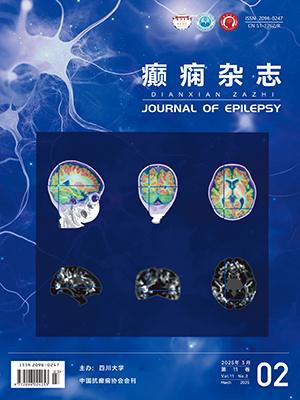| 1. |
Kaseka ML, Bitton JY, Décarie JC, et al. Predictive factors for epilepsy in pediatric patients with Sturge-Weber syndrome. Pediatr Neurol, 2016, 64: 52-58.
|
| 2. |
Marana Pérez AI, Ruiz-FalcóRojas ML, Puertas Martín V, et al. Analysis of Sturge-Weber syndrome: a retrospective study of multiple associated variables. Neurologia( Barcelona, Spain), 2017, 32(6): 363-370.
|
| 3. |
Sudarsanam, Annapurna, Ardern-Holmes, Simone L. Sturge–Weber syndrome: From the past to the present. Eur J PaediatrNeurol, 2014, 18(3): 257-266.
|
| 4. |
Shirley M D, Tang H, Gallione C J, et al. Sturge-Weber syndrome and port-wine stains caused by somatic mutation in GNAQ. N. Engl J Med, 2013, 368(21): 1971-1979.
|
| 5. |
Polubothu S, A-Olabil, Carmen Del Boente M, et al. GNA11 mutation as a cause of Sturge-Weber syndrome: expansion of the phenotypic spectrum of G-protein related mosaicism and the associated clinical diagnoses. J Invest Dermatol, 2020, 140(5): 1110-1113.
|
| 6. |
Sujansky E, Conradi S. Outcome of Sturgee Webersyndrome in 52 adults. Am J Med Genet, 1995, 57: 35-45.
|
| 7. |
Jagtap S, Srinivas G, Harsha KJ, et al. SturgeeWeber syndrome: clinicalspectrum, disease course, and outcome of 30 patients. J ChildNeurol, 2013, 28(6): 725-731.
|
| 8. |
Pascual-Castroviejo I, Pascual-Pascual SI, Velazquez-Fragua R, et al. SturgeeWeber syndrome: study of 55 patients. Can J NeurolSci, 2008, 35: 301-307.
|
| 9. |
Anne M. Comi. Chapter 11 - Sturge–Weber syndrome[M]// Handbook of Clinical Neurology. Elsevier Health Sciences, 2015.
|
| 10. |
Comi, Anne M. Presentation, diagnosis, pathophysiology, and treatment of the neurological features of Sturge-Weber syndrome. The Neurologist, 2011, 17(4): 179-184.
|
| 11. |
Weber, F. P . Right-sided hemi-hypotrophy resulting from right-sided congenital spastic hemiplegia, with a morbid condition of the left side of the brain, revealed by radiograms. Journal of Neurology Neurosurgery & Psychiatry, 1922, 16: 102-108.
|
| 12. |
Thomas-Sohl KA, Vaslow DF, Maria BL. Sturge-Weber syndrome: A review. Pediatric neurology, 2004, 30(5): 303.
|
| 13. |
许新科, 谢艳平, 李军亮, 等. 儿童Sturge-Weber综合征继发癫痫的外科治疗. 中华小儿外科杂志, 2020, 41(2): 140-144.
|
| 14. |
李沐阳, 张华强, 安阳, 等. Sturge-Weber综合征继发药物难治性癫痫的手术治疗及文献回顾. 中国脑血管病杂志, 2020, 17(1): 44-48.
|
| 15. |
BAFLA, CsabaJuhász, CJAL, et al. Neurological complications of Sturge-Weber syndrome: Current status and unmet needs. Pediatric Neurology, 2019, 98: 31-38.
|
| 16. |
Eric H. Kossoff, Lisa Ferenc, Anne M. Comi. An infantile-onset, severe, yet sporadic seizure pattern is common in Sturge-Weber syndrome. Epilepsia, 2009, 53(5): 8-906-912.
|
| 17. |
Brenner RP, Sharbrough FW. Electroencephalographic evaluationin Sturge Weber syndrome. Neurology, 1976, 26: 629-632.
|
| 18. |
刘晓燕. 临床脑电图学. 2006.
|
| 19. |
Fukuyama Y, Tsuchiya S. A study on Sturge-Webersyndrome. Report of a case associated with infantile spasms and electroencephalographic evolution in five cases. EurNeurol, 1979, 18: 194-204.
|
| 20. |
Reith W, Yilmaz U, Zimmer A. Sturge-Weber-Syndrom. Der Radiologe, 2013, 53(12): 1099-1103.
|
| 21. |
Michaela Z, Mackay M T, Leventer R J, et al. Retrospective review of screening for Sturge‐Weber syndrome with brain magnetic resonance imaging and electroencephalography in infants with high‐risk port‐wine stains. Pediatric Dermatology, 2018, 16(2): 206-212.
|
| 22. |
张玉珍, 尹秋凤, 蔡静, 等. 儿童Sturge-Weber综合征影像学诊断. 中国临床医学影像杂志, 2020, 313): 154-158.
|
| 23. |
刘长青, 陈思畅, 关宇光, 等. Sturge-Weber综合征所致难治性癫痫的手术治疗. 中国临床神经外科杂志, 2017, (6): 379-381.
|
| 24. |
Bianchi F, Auricchio AM, Battaglia DI, et al. Sturge-Weber syndrome: an update on the relevant issues for neurosurgeons. Child s Nervous System, 2020, (7): 256-261.
|
| 25. |
Kossoff EH, Buck C, Freeman JM. Outcomes of 32 hemispherectomies for Sturge-Weber syndrome worldwide. Neurology, 2002, 59(11): 1735.
|
| 26. |
Arzimanoglou AA, Andermann F, Aicardi J, et al. Sturge-Weber syndrome: indications and results of surgery in 20 patients. Neurology, 2000, 55(10): 1472-1479.
|




